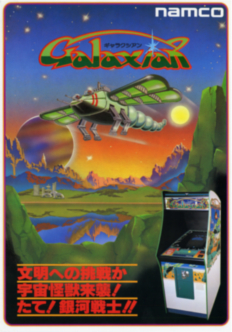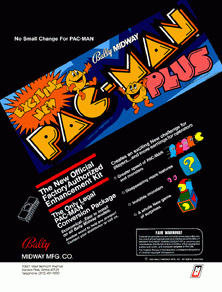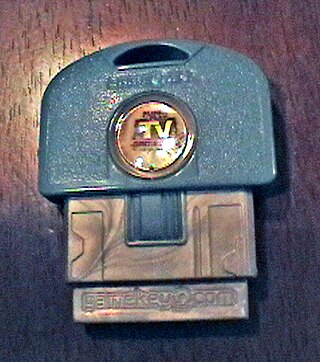
Coleco Industries, Inc. was an American company founded in 1932 by Maurice Greenberg as The Connecticut Leather Company. It was a successful toy company in the 1980s, mass-producing versions of Cabbage Patch Kids dolls and its video game consoles, the Coleco Telstar dedicated consoles and ColecoVision. While the company ceased operations in 1988 as a result of bankruptcy, the Coleco brand was revived in 2005, and remains active to this day.

A video game console is an electronic device that outputs a video signal or image to display a video game that can be played with a game controller. These may be home consoles, which are generally placed in a permanent location connected to a television or other display devices and controlled with a separate game controller, or handheld consoles, which include their own display unit and controller functions built into the unit and which can be played anywhere. Hybrid consoles combine elements of both home and handheld consoles.

Galaxian is a 1979 fixed shooter arcade video game developed and published by Namco. The player assumes control of the Galaxip starfighter in its mission to protect Earth from waves of aliens. Gameplay involves destroying each formation of aliens, who dive down towards the player in an attempt to hit them.

Radica Games Limited was a Hong Kong company that produced electronic games, founded in 1983. It began by producing electronic souvenir games for casinos. In the late 1990s, it became known for its Bass Fishin line of games. On October 3, 2006, Mattel, Inc. announced the completion of their acquisition of Radica. While Radica produced electronic handheld games based on casino or card games, it has branched out into toys, board games, and video game accessories.

Pac-Man Plus is an arcade game that was developed by Namco and released by Bally Midway in 1982. It is part of the Pac-Man series of games.

Jakks Pacific, Inc. is an American toy manufacturer founded in January 1996. The company is best known for producing licensed action figures, playsets, dolls, plush toys and dress-up sets.

The Cassette Vision is a second generation home video game console made by Epoch Co. and released in Japan on July 30, 1981. A redesigned model called the Cassette Vision Jr. was released afterwards.
A dedicated console is a video game console that is limited to one or more built-in video game or games, and is not equipped for additional games that are distributed via ROM cartridges, discs, downloads or other digital media. Dedicated consoles were popular in the first generation of video game consoles until they were gradually replaced by second-generation video game consoles that use ROM cartridges.
Namco Museum is a series of video game compilations developed and published by Bandai Namco Entertainment for home video game consoles. The first title in the series, Namco Museum Vol. 1, was released for the PlayStation in 1995. Entries in the series have been released for multiple platforms, including the Game Boy Advance, PlayStation 2, PlayStation Portable, Nintendo DS and Xbox 360. the latest being Namco Museum Archives Vol. 2, released in 2020.
Techno Source is a handheld electronic game and TV game company selling electronic toys, games and learning aids. Based in Hong Kong with an office in New York City, it is a privately owned company founded in 2000 by Wayne Nathan and Rich Migatz. In April 2011, Techno Source was acquired by Li & Fung.

Plug-&-Play TV Games is a series of Plug-n-play game devices produced by Jakks Pacific.

The Japanese multinational consumer electronics company Nintendo has developed seven home video game consoles and multiple portable consoles for use with external media, as well as dedicated consoles and other hardware for their consoles. As of September 30, 2021, in addition to Nintendo Switch, Nintendo has sold over 863.07 million hardware units.
Entex Industries, Inc. was an American toy and electronic game manufacturer based in Compton, California. The company was active during the 1970s and 1980s.

GameKeys are expansion modules made by Jakks Pacific for the purpose of adding games to GameKey-ready entries in their Plug It In & Play TV Games product line.
Toys-to-life is a video game feature using physical figurines or action figures to interact within the game. These toys use a near field communication (NFC), radio frequency identification (RFID), or image recognition data protocol to determine the individual figurine's proximity, and save a player's progress data to a storage medium located within that piece. It was one of the most lucrative branches of the video game industry especially during the late 1990s and 2010s, with the Skylanders franchise alone selling more than $3 billion worth over the course of four years.
AtGames Cloud Holdings Inc. is an American video game and console manufacturer, known for their Legends Ultimate Arcade and the creator of the connected arcade. Since 2011, they have produced and marketed the Atari-licensed dedicated home video game console series Atari Flashback under license from Atari. Additionally, AtGames has produced ColecoVision and Intellivision Flashback consoles, and has worked with Sega on multiple different handhelds and retro consoles.

The Evercade is a handheld game console developed and manufactured by British company Blaze Entertainment. It focuses on retrogaming with ROM cartridges that each contain a number of emulated games. Evercade was released in May 2020 and upon its launch offered 10 game cartridges with a combined total of 122 games.

Evercade VS is a video game console developed by British company Blaze Entertainment. It is an upgraded home console version of the original Evercade handheld that introduces multiplayer functionality. It was released in December 2021 in Europe, and on 25 February 2022 in the United States.













